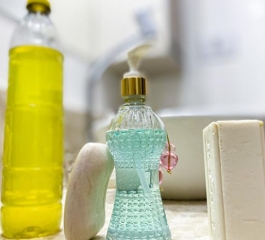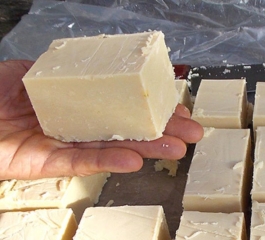Essential Oils
Essential oils are used to give homemade disinfectant a pleasant aroma. They also have antibacterial and antifungal properties. The most common essential oils used in homemade disinfectants are lavender oil, lemon oil, and eucalyptus oil. Essential oils can be found in health food stores or online.
Manufacturing Process
Preparation
Before starting the process of making homemade disinfectant, it is important to ensure that all the necessary materials are available. The main ingredients are water, 70% ethyl alcohol and a disinfectant agent such as sodium hypochlorite.
In addition, you will need a container to mix the ingredients and another to store the disinfectant.
Mix
To make homemade disinfectant, the first step is to mix water and ethyl alcohol in a 3:1 ratio. Then, the disinfectant agent must be added to the mixture in the amount recommended by the manufacturer.
It is important to follow the disinfectant agent instructions carefully, as the amount needed may vary depending on the type and concentration of the product.
The mixture should be stirred vigorously for a few minutes to ensure that all ingredients are well mixed. It is important to remember that homemade disinfectant is not recommended for disinfecting surfaces that come into contact with food, as it can leave toxic residues.
Storage
After mixing, the homemade disinfectant should be stored in a clean, dry container, with a tightly closed lid. It is recommended to label the container with the date of manufacture and list of ingredients to avoid confusion.
Homemade disinfectant has a shelf life of about one month and should be kept out of the reach of children and pets.
It is important to remember that homemade disinfectant does not replace regular cleaning with soap and water, but it can be a useful option for disinfecting surfaces in times of need.
Precautions When Using Homemade Disinfectant
When using homemade disinfectant, it is important to take some precautions to ensure the safety and effectiveness of the product. Here are some tips to help avoid problems:
- Always read the instructions carefully before using homemade disinfectant. Make sure you understand all information and precautions.
- Wear rubber gloves and protective glasses when handling the disinfectant. This will help protect your skin and eyes from possible irritation or injury.
- Do not mix different types of homemade disinfectants. This can cause dangerous chemical reactions that can be harmful to your health.
- Keep the disinfectant out of the reach of children and pets. Make sure the product is stored in a secure, closed location.
- Do not use homemade disinfectant on surfaces that could be damaged by the product. Always test a small area before using the disinfectant on a larger surface.
- Avoid using the disinfectant in areas with inadequate ventilation. Make sure there is adequate ventilation to avoid inhaling toxic fumes.
By following these precautions, you can ensure that homemade disinfectant is safe and effective for use in your home. Always remember to read the instructions carefully and take the necessary precautions to ensure your safety.
Benefits of Homemade Disinfectant
The use of homemade disinfectants can bring several benefits to health and the environment. Check out some of the main benefits below:
1. Economy
One of the main advantages of homemade disinfectant is the economy. The ingredients used in its production are easily found in supermarkets and cleaning products stores, and are usually cheaper than industrialized disinfectants.
2. Personalization
By producing your own disinfectant, you can customize the fragrance and color according to your preferences. Furthermore, it is possible to control the quantity of product produced, avoiding waste.
3. Fewer chemicals
Industrialized disinfectants tend to contain a large amount of chemicals, which can be harmful to health and the environment. By producing your own disinfectant, you can use more natural and less aggressive ingredients.
4. Disinfectant effect
Homemade disinfectant can have as effective a disinfectant effect as industrialized ones, as long as it is produced correctly. Some of the ingredients most used in the production of homemade disinfectants, such as vinegar and baking soda, have antimicrobial properties and can help eliminate germs and bacteria.
5. Sustainability
By using more natural ingredients in the production of homemade disinfectants, it is possible to contribute to preserving the environment. Furthermore, by producing your own disinfectant, it is possible to reduce the amount of packaging discarded in the environment.
Disadvantages of Homemade Disinfectant
While homemade disinfectant may seem like an economical and environmentally friendly option, there are some drawbacks to consider.
Firstly, the effectiveness of homemade disinfectant can be questionable. The concentration of active ingredients may vary depending on the recipe and the quality of the ingredients used.
This can result in a final product that is not as effective at killing germs and bacteria as a commercial disinfectant.
Also, homemade disinfectant may not be as safe as commercial products. Ingredients like vinegar and lemon can be acidic enough to damage sensitive surfaces like marble and granite. Excessive use of essential oils can cause skin and eye irritation.
Another disadvantage of homemade disinfectant is that it may not be as durable as a commercial product. Without preservatives and stabilizers, homemade disinfectant can deteriorate more quickly and lose effectiveness over time.
Finally, homemade disinfectant may not be as convenient as a commercial product. Preparing homemade disinfectant can take time and effort, and the lack of convenient packaging can make storing and using the product more complicated.
On the next and final page, see the conclusion and a series of questions about homemade disinfectant that could be yours too!







